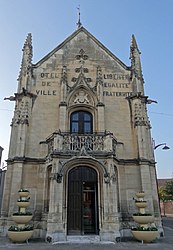Breteuil (French pronunciation: [bʁətœj]), also known as Breteuil-sur-Iton ("Breteuil-on-Iton"), is a commune in the Eure department in Normandy in northern France. On 1 January 2016, the former communes Cintray and La Guéroulde were merged into Breteuil.[3]
Breteuil | |
|---|---|
 The town hall in Breteuil | |
| Coordinates: 48°50′13″N 0°54′53″E / 48.8369°N 0.9147°E | |
| Country | France |
| Region | Normandy |
| Department | Eure |
| Arrondissement | Bernay |
| Canton | Breteuil |
| Intercommunality | Normandie Sud Eure |
| Government | |
| • Mayor (2020–2026) | Gérard Chéron[1] |
| Area 1 | 55.05 km2 (21.25 sq mi) |
| Population (2021)[2] | 4,287 |
| • Density | 78/km2 (200/sq mi) |
| Demonym | Bretoliens |
| Time zone | UTC+01:00 (CET) |
| • Summer (DST) | UTC+02:00 (CEST) |
| INSEE/Postal code | 27112 /27160 |
| Elevation | 157–197 m (515–646 ft) (avg. 179 m or 587 ft) |
| 1 French Land Register data, which excludes lakes, ponds, glaciers > 1 km2 (0.386 sq mi or 247 acres) and river estuaries. | |
History
editDuring the Middle Ages, Breteuil was the seat of a lordship in the duchy of Normandy. Its lord William FitzOsbern was a companion of William during his conquest of England in 1066. His son William of Breteuil served as a Benedictine abbot before inheriting Breteuil and was later canonized as a saint by the Roman Catholic Church. His illegitimate son Eustace of Breteuil married Juliane de Fontevrault, the illegitimate daughter of King Henry I of England, who feuded with her father and eventually lost control of the lordship.
Population
edit| Year | Pop. | ±% p.a. |
|---|---|---|
| 1968 | 3,976 | — |
| 1975 | 4,259 | +0.99% |
| 1982 | 4,219 | −0.13% |
| 1990 | 4,280 | +0.18% |
| 1999 | 4,456 | +0.45% |
| 2007 | 4,521 | +0.18% |
| 2012 | 4,553 | +0.14% |
| 2017 | 4,424 | −0.57% |
| Source: INSEE[4] | ||
See also
editReferences
edit- ^ "Répertoire national des élus: les maires" (in French). data.gouv.fr, Plateforme ouverte des données publiques françaises. 13 September 2022.
- ^ "Populations légales 2021" (in French). The National Institute of Statistics and Economic Studies. 28 December 2023.
- ^ Arrêté préfectoral 9 December 2015 (in French)
- ^ Population en historique depuis 1968, INSEE



